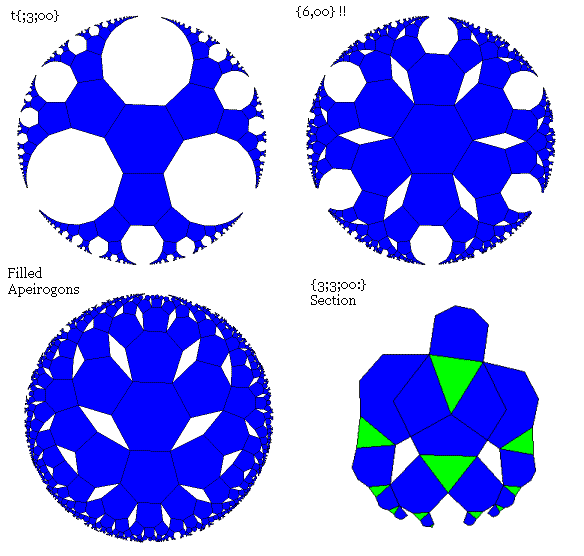
copyright 08/18/2002
Wendy Krieger

 |
apeiroblue.png copyright 08/18/2002 Wendy Krieger |
 |

This foursome of figures shows variations on a truncated {3,oo}.
The first is the t{;3;oo} itself. The infinite-sided polygons (apeirogons) appear as the largish white circles. It forms the underlying base for the next two pictures as well.
The second frame shows what happens if it is give a 30 degree turn around the centre. All the original faces are still there, along with 75% additional faces. This has now acquired the symmetry of a {6,oo}. The verticies of the {oo,6} appear at the centres of the hexagons with six neighbours. The edges run along the long diagonal of the rhombs.
What is unusual here is that by the construction, both the {oo,3} and {oo,6} share the same face planes !!! That is, the way we added extra hexagons neither increased nor decreased the number of apeirogons, and therefore their number and position is unchanged.
The third frame shows a filled apeirogons. This is one of the diagrams that convinced me that apeirogons have a logrithmetic centre.
The Little Man
The fourth frame is some small segment from {3;3;oo:}. In real life, this looks like a bow (for shooting arrows), or a part of a circle cut off by a chord. The poincoire projection has converted it into a little man. [The string on the bow is his feet and groin. The bow is his rather muscular arms. The (loaded) arrow is the head and body).
The interesting thing here is that the hexagons that form the head and body are not part of this honeycomb. The body hexagon is wedged in between the two triangles. The head would point to a triangle in the next layer.
back to Gallery index
back to Tyler Applet
back to Geometry index
back to Superliminal home